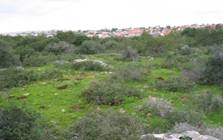Dynamics of the Mediterranean vegetation mosaic: modeling across spatial scales from simple to complex
Avi Bar-Massada, Gili Koniak1, Yohay Carmel, and Imanuel Noy-Meir1.
1Faculty of Agriculture, Hebrew University of Jerusalem
 East Mediterranean ecosystems have been disturbed by clearing, burning and grazing for 10,000 years. Consequently, the landscape was shaped into fine-grained vegetation mosaics, consisting of patches of vegetation states at different regeneration stages, with high structural and species diversity. Recent land use changes allowed spontaneous succession processes to transform large areas in the Mediterranean basin into continuous dense scrub forest, with reduced diversity and high fire risk. Grazing, clearing and fire could possibly be managed to conserve or restore mosaic landscapes. However, the long term interactions between these disturbances and spontaneous vegetation processes are not fully understood, hindering the development of management programs. In order to understand and predict the spatiotemporal dynamics of Mediterranean vegetation under multiple disturbances, we are developing mathematical models across three spatial scales: patch, site and landscape. The models are constructed by successive approximations, from simple to complex, registering the changes in model behavior and realism at each stage. Starting, at the patch scale, from Markov-type transition probabilities between five dominant vegetation states, ecological realism was increased by expressing probabilities as explicit functions of biological processes (recruitment, expansion, mortality) and of disturbances (grazing, fire, clearing). In up-scaling from patch to site scale, neighborhood effects on expansion and recruitment processes were represented alternatively by diffuse or by spatially explicit functions. Up-scaling to the landscape scale allows representing differences in disturbance history between sites. Simulations with a current version of the model successfully mimic general trends in Mediterranean vegetation observed over past decades. Without disturbance, grassland with few shrubs transforms into dense scrub forest within 100 years. Under intense goat grazing, dwarf shrubs gain dominance after 30 years, while other woody types remain stable. Burning or clearing are followed by full regeneration of woody vegetation within 25 years, unless checked by intense goat grazing.
East Mediterranean ecosystems have been disturbed by clearing, burning and grazing for 10,000 years. Consequently, the landscape was shaped into fine-grained vegetation mosaics, consisting of patches of vegetation states at different regeneration stages, with high structural and species diversity. Recent land use changes allowed spontaneous succession processes to transform large areas in the Mediterranean basin into continuous dense scrub forest, with reduced diversity and high fire risk. Grazing, clearing and fire could possibly be managed to conserve or restore mosaic landscapes. However, the long term interactions between these disturbances and spontaneous vegetation processes are not fully understood, hindering the development of management programs. In order to understand and predict the spatiotemporal dynamics of Mediterranean vegetation under multiple disturbances, we are developing mathematical models across three spatial scales: patch, site and landscape. The models are constructed by successive approximations, from simple to complex, registering the changes in model behavior and realism at each stage. Starting, at the patch scale, from Markov-type transition probabilities between five dominant vegetation states, ecological realism was increased by expressing probabilities as explicit functions of biological processes (recruitment, expansion, mortality) and of disturbances (grazing, fire, clearing). In up-scaling from patch to site scale, neighborhood effects on expansion and recruitment processes were represented alternatively by diffuse or by spatially explicit functions. Up-scaling to the landscape scale allows representing differences in disturbance history between sites. Simulations with a current version of the model successfully mimic general trends in Mediterranean vegetation observed over past decades. Without disturbance, grassland with few shrubs transforms into dense scrub forest within 100 years. Under intense goat grazing, dwarf shrubs gain dominance after 30 years, while other woody types remain stable. Burning or clearing are followed by full regeneration of woody vegetation within 25 years, unless checked by intense goat grazing.
